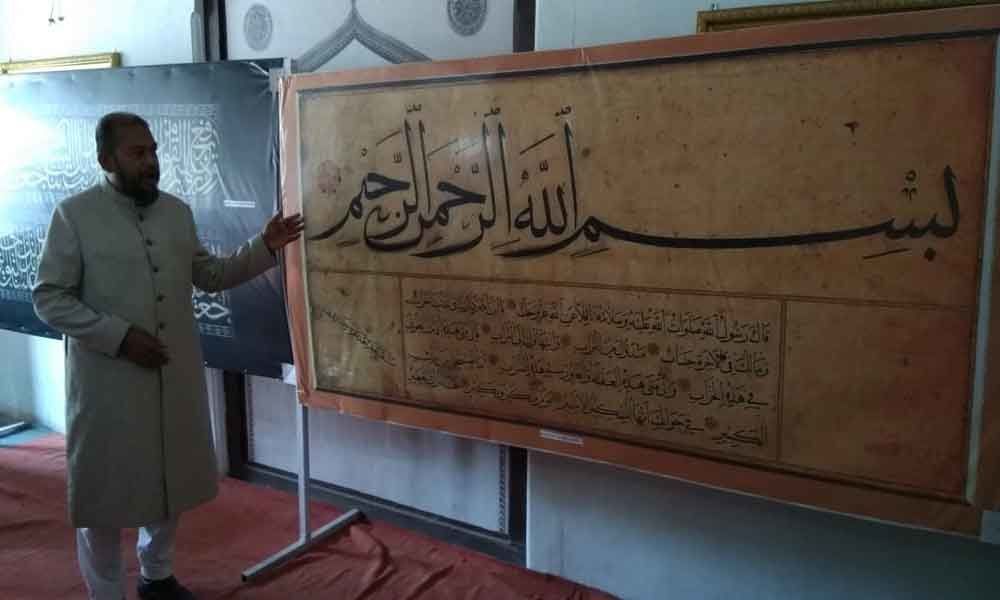Live
- ‘Get Set, Grow Summit 2024’ Focuses on Digital Detox for Families
- Stokes motivates his team to put in extra effort, says England pacer Potts
- From overcoming setbacks to leading India in U19 Women’s Asia Cup, Niki Prasad's amazing journey
- Driving Enterprise Security: Inside Venkata Reddy Thummala’s Leadership Journey
- Constitution debate: PM Modi hails 'Nari Shakti'; makes strong pitch for 'United Bharat’
- Abhijeet Bhardwaj: Revolutionizing Enterprise Analytics with Innovation and Expertise
- Bihar: Inquiry initiated against principal who went to buy veggies during school hours
- Press Sri Lankan Prez for release of Indian fishermen: TN Cong MP to EAM Jaishankar
- TN: DMK postpones executive meet due to heavy rains & Parliament session
- Porous silicon oxide electrodes can fix durability issues in batteries: Researchers
Just In

A 300-year old piece of Kiswah (cloth that covers the Kaaba in Mecca, Saudi Arabia) brought by Mir Qamaruddin Khan Siddiqi Bayafandi (Asaf Jah I) remains as one of the top attractions being showcased at the Nizam’s Museum for the Holy month of Ramzan.
Purani Haveli: A 300-year old piece of Kiswah (cloth that covers the Kaaba in Mecca, Saudi Arabia) brought by Mir Qamaruddin Khan Siddiqi Bayafandi (Asaf Jah I) remains as one of the top attractions being showcased at the Nizam's Museum for the Holy month of Ramzan.
Being organised for the first time at the Nizam's Museum in Purani Haveli, the exhibition of rare and antique copies of 'Quranic manuscripts' in different calligraphic styles is attracting the devout as well as the history buffs and art lovers.
At this 14-day exhibition, which will conclude on June 9, some of the centuries old manuscripts of Quranic scripts are written in different shapes and styles like Kufie, Hajazi, Ma'el, Maghrabi, Naskh, Thulth, Taugi, Riqa, Muhagaq, Rayhan, Nastalig, Ghubar, Bahar and Chinese style etc. "These manuscript copies were collected from Turkey, Iran, Iraq, India, China, South Africa, Egypt, Tunisia, Spain and Saudi Arabia and are showcased for the first time in this exhibition", said Ahmed Ali, Curator, the HEH Nizam Museum.
Speaking to The Hans India here on Friday, Ahmed Ali said that, in the holy month of Ramzan, the HEH Nizam Museum organised this free Quranic exhibition for which the Hyderabadi Muslims could perform Ziyarat (glance a holy thing) in this month.
He said that the devout could have a glimpse, as the antique and rare manuscripts display verses of Quran, which are collected from the Asia and Gulf countries. "This is the first Quranic exhibition held at the HEH Nizam Museum. In this exhibition there are a total of 58 Quranic Manuscripts copies which are being showcased, with total 14 different types of works", he added.
Copies of five Quranic revelations
Ahmed Ali said that the collection also includes 'copies of five Quranic revelations' scribed on leather during the time of Prophet Mohammad and some pieces scribed by renowned calligraphers Yakut Al Mustasami of Iraq, Abdullah Assirafi of Iran and HamdullahAlamasi of Turkey. "There is also a piece of 'Kiswah' (which is more than 300 years old brought by Mir Qamaruddin Khan Siddiqi Bayafandi (Asaf Jah I) at the exhibition. There is also a personal Quran of Nizam VII with its silver box is also displayed in the exhibition", he explained.
He also said that the verse of Quran is showcased in different styles of calligraphy, which includes works of embroidery and Kashmiri works from Indian sub-continent.
"Almighty Allah sent Prophet Mohammad to preach and confirm the revelations of the holy books- 'Zabur' revealed on Dawood (David), 'Taurat' revealed on Musa (Moses) and 'Injeel' revealed on Esa (Christ). The last glorious book- the Quran, was revealed to Mohammad in the year 622 CE (AD) at the cave of Hira in Mecca, Saudi Arabia. The revelations continued for a period of 23 years.
The Quran is the last testament of Allah to guide the people and educate them on how to live a decent life with guidelines given by the mentor Prophet Muhammad," he explained, while throwing some light about the importance of holy scripture. This exhibition is being visited by many non-Muslims mostly history buffs and art lovers to see the different types of calligraphies.
"This exhibition also explains the development of calligraphy from its origin and also history of different types of calligraphies," he explained The exhibition also displayed exclusively embroidered Quranic chapter and verses like SurehAqlas, Sureh Yaseen, SurehQuresh by Hyderabadi artist, Meherunissa Begum.
City's renowned Calligrapher, Mohammed Zameeruddin Al-Khudri Nizami is also regularly visiting the exhibition and can be seen explaining the different types of Calligraphies to the visitors at the exhibition.
By M M Farooqui

© 2024 Hyderabad Media House Limited/The Hans India. All rights reserved. Powered by hocalwire.com







